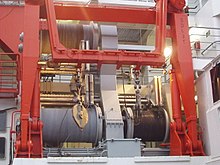Meteor (ship, 1986)
|
||||||||||||||||||
|
||||||||||||||||||
|
||||||||||||||||||
|
||||||||||||||||||
|
||||||||||||||||||
|
||||||||||||||||||
The Meteor is a multi-disciplinary research ship that serves German deep sea research in cooperation with other countries in this field. The University of Hamburg acts as the operator .
history
The Meteor is the third German research ship of this name. It was built in 1985/86 at the Schlichting shipyard in Travemünde under construction number 2030. The keel was laid on March 13, 1985, the launch on September 3, 1985. The ship was completed in February 1986 and put into service on March 15, 1986. It enables scientists from universities and other research institutions in the German states and the federal government to conduct basic research and is constantly being modernized.
description
The ship is owned by the Federal Republic of Germany, represented by the Federal Ministry of Education and Research (BMBF), which also paid for the construction costs. The operating costs (including equipment, repairs, permanent staff) are borne by the German Research Foundation (DFG) as a so-called auxiliary research facility and 30 percent by the BMBF , depending on the use . The coordination of scientific voyage planning was up to 2017 with the Senate Commission for Oceanography as the planning and support center for the activities of the DFG in marine research and was then taken over by the Expert Panel Research Vessels (GPF) set up by the Federal Ministry of Education and Research and the German Research Foundation. The scientific-technical, logistical and financial preparation, handling and supervision of the ship operation is carried out by the Meteor / Merian control center at the Institute for Oceanography of the University of Hamburg . The shipping company F. Laeisz (Bremerhaven) will manage the ship until the end of 2012 . The tender for the management of the ship from 2013 onwards was won by the Leer- based company Briese Schiffahrt .
The Meteor is used worldwide in the fields of marine geology , oceanography , maritime biology , marine chemistry and ecology .
Technical data and equipment
The ship is powered by diesel-electric technology . When traction motors two electric motors of the manufacturer are LDW settlement GmbH in Bremen, each with 1,150 kW power available that act directly on the fixed propeller.
Four generator sets are available for the power supply. Four diesel engines , each with an output of 1,000 kW, drive four three-phase generators , each with an apparent output of 1,350 kVA . A diesel generator with 342 kW (390 kVA apparent power) is available for port operations. The emergency diesel has an output of 81.9 kW (apparent power 93 kVA).
There are 20 research laboratories on board . The ship also has several winches and various cranes for research , including a stern boom . Even underwater glider used by the board of Meteor. as well as lander . In addition, the ship is for scientific purposes u. a. equipped with echo sounder systems.
There are several parking spaces for 10 and 20 foot containers on board . A 40-foot container can also be loaded on the main deck.
The Meteor offers accommodation for 32 crew members as well as 28 scientists and up to two employees of the German Weather Service , who are responsible for the on-board weather station. A weather radio technician is always on board, and a meteorologist if necessary .
There are 13 double cabins and two single cabins available for the scientists, and two additional single cabins for the employees of the German Weather Service.
The ship can remain at sea continuously for 45 to 50 days, covering 10,000 nautical miles .
literature
- N. Jakobi, H. von Neuhoff, B. Springer (Hrsg.): 25 years RV Meteor: A research ship and its history (s) . Hauschild, Bremen 2011. ISBN 3-89757-507-8
- Gregor Rehder, Holger von Neuhoff, Stephanie von Neuhoff: Deep Sea Expedition: Research vessel METEOR on the trail of the last secrets of our earth . Franckh-Kosmos, Stuttgart 2006. ISBN 3-440-10708-6
See also
Web links
- RV METEOR , Control Center for German Research Vessels , University of Hamburg
- RV METEOR, technical information and plans , control center for German research vessels, University of Hamburg
- Weekly reports and short cruise reports , Control Center for German Research Vessels, Institute for Oceanography
- On-board manual for expedition participants (PDF, 35.2 MB)
- Guidelines for preparing and carrying out expeditions with RV METEOR, RV MARIA S. MERIAN and RV SONNE , Institute of Geology at the University of Hamburg, Control Center for German Research Vessels (LDF) and Office of the Expert Panel Research Vessels (GPF), March 2019 (PDF, 1.1 MB)
- List of all trips made so far with links to the scientific trip reports
- Report on the 30th anniversary of Meteor on the DFG website (2016)
Individual evidence
- ↑ a b New shipowner for the research vessel Meteor , press release, Federal Ministry of Education and Research, August 9, 2012. Accessed on May 7, 2019.
- ↑ a b Research ship Meteor , DFG
- ^ Senate Commission for Oceanography , Finished Senate Commissions, German Research Foundation. Retrieved May 7, 2019.
- ^ RV Meteor , Control Center for German Research Vessels, IfM Hamburg.
- ↑ Andreas Villwock: A swarm for research - IFM-GEOMAR is using new high-tech measuring robots for the first time in the association. Leibniz Institute for Marine Sciences, Kiel, January 14, 2010, accessed on February 11, 2013 .
- ↑ On- board weather station FS Meteor , DWD, ( PDF, 3.4 MB; as of December 9, 2015 )


